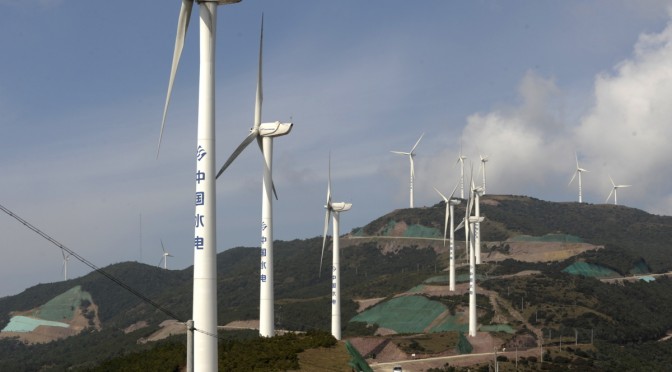The mainland’s National Development and Reform Commission is consulting the renewables industry on cutting wind power prices by an average of 6 per cent.
Beijing should think twice before cutting wind power tariffs because such a move could see the wind power industry fall short of Beijing’s development target for 2020, mainland wind farm developers have warned.
But power distribution executives said the lowering of clean and renewable power prices was an inevitable trend, given that industries should not rely on long-term subsidies and could only become competitive by lowering costs.
The National Development and Reform Commission, the mainland’s energy price regulator, is consulting the industry on cutting wind power prices by an average of 6 per cent.
Lower prices were proposed last year after sharp falls in turbine prices cut operating costs, but did not happen amid opposition from wind farm developers and Beijing’s declaration of war against air pollution.
While the timing of the proposed cuts remains unclear, the industry is debating whether they should be imposed in the middle of next year or at the start of 2016. They would be the first adjustment in wind power prices since the introduction of subsidised tariffs in 2009.
“As the fair environmental costs have not been fully reflected in coal-fired power prices, it would be questionable whether the 200 gigawatt [accumulated] installation target for 2020 can be reached if wind power prices are cut by so much,” Ren Guangjin, director of wind farm development at Hong Kong-listed China WindPower told the China Wind Power conference in Beijing this week.
Lu Yichuan, deputy chief engineer at China Longyuan Power, Asia’s largest wind farm operator, said Beijing should not cut prices industry-wide “just because certain operators have reported good financial results”.
WindPower’s profit fell 21 per cent last year to 2.05 billion yuan (HK$2.59 billion) on the back of a sharp drop in income from carbon reduction credits and higher maintenance and operating costs. Profit fell 6.8 per cent year on year in the first half of this year.
Power prices should not be pared while long-running power grid bottlenecks remained and while billions of yuan in power price subsidies owed by government remained in arrears, said Hu Guodong, deputy general manager of Hong Kong-listed China Datang Corporation Renewable Power.
“To reach the 2020 target, we need up to a trillion yuan of investment,” he said. “Only projects with decent returns will attract investors.”
China Datang, heavily exposed to the Inner Mongolia autonomous region, which has suffered from some of the mainland’s worst wind power dispatch curtailment – the reduction of output due to grid bottlenecks – posted a net loss of 14.4 million yuan in the first half of this year, compared with a profit of 231 million yuan in the first half of last year, as output fell 9 per cent.
Power distributors have a different perspective.
Hou Youhua, deputy director of Inner Mongolia Power’s dispatch centre, said solar and wind power must enhance their competitiveness versus hydro and coal-fired power.
“Falling renewable power prices should be a trend, otherwise, high prices would not be conducive to development,” he said.
Wang Ningbo, director of Gansu Electric Power’s wind power technology centre, said renewable energy could only hope to become a mainstream source of electricity if the project developers reduced costs by adopting more advanced technology and improved management.
Besides proposing a power price cut, Beijing is also consulting the industry on the imposition of minimum renewable power procurement quotas on provincial governments and power grid operators.
Credit Suisse regional head of utilities research Dave Dai estimated in a research report last month that the proposed price cut could reduce Hong Kong-listed mainland wind farm operators’ earnings per share by 1 per cent to 3 per cent next year and in 2016 if implemented at the start of next year. But the impact could be mitigated if the procurement quotas were implemented at the same time.



